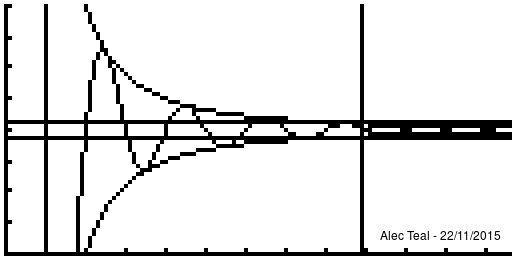Limit (sequence)/Discussion of definition
The idea is that defining "tends towards [ilmath]x[/ilmath]" is rather difficult, to sidestep this we just say "we can get as close as we like to" instead. This is the purpose of [ilmath]\epsilon[/ilmath].
We say that "if you give me an [ilmath]\epsilon>0[/ilmath] - as small as you like - I can find you a point of the sequence ([ilmath]N[/ilmath]) where all points after are within [ilmath]\epsilon[/ilmath] of [ilmath]x[/ilmath] (where [ilmath]d(\cdot,\cdot)[/ilmath] is our notion of distance)
- That is after [ilmath]N[/ilmath] in the sequence, so that's [ilmath]x_{n+1},x_{n+1},\ldots[/ilmath] the distance between [ilmath]x_{N+i} [/ilmath] and [ilmath]x[/ilmath] is [ilmath]<\epsilon[/ilmath]
- This is exactly what [ilmath]n>N\implies d(x_n,x)<\epsilon[/ilmath] says, it says that:
- whenever [ilmath]n>N[/ilmath] we must have [ilmath]d(x_n,x)<\epsilon[/ilmath]
- This is exactly what [ilmath]n>N\implies d(x_n,x)<\epsilon[/ilmath] says, it says that:
As per the nature of implies we may have [ilmath]d(x_n,x)<\epsilon[/ilmath] without [ilmath]n>N[/ilmath], it is only important that WHENEVER we are beyond [ilmath]N[/ilmath] in the sequence that [ilmath]d(x_n,x)<\epsilon[/ilmath]
Notice that at [ilmath]x=1[/ilmath] that , in fact the curve is within [ilmath]\pm\epsilon[/ilmath] several times before we reach the vertical line, this is the significance of the implies sign, when we write [ilmath]A\implies B[/ilmath] we require that whenever [ilmath]A[/ilmath] is true, [ilmath]B[/ilmath] must be true, but [ilmath]B[/ilmath] may be true regardless of what [ilmath]A[/ilmath] is.
Note that after the vertical line the function is always within the bounds.
Because of this any [ilmath]N'>N[/ilmath] may be used too, as if [ilmath]n>N'[/ilmath] and [ilmath]N'>N[/ilmath] then [ilmath]n>N'>N[/ilmath] so [ilmath]n>N[/ilmath] - this proves that if [ilmath]N[/ilmath] works then any larger [ilmath]N'[/ilmath] will too. There is no requirement to find the smallest [ilmath]N[/ilmath] that'll work, just an [ilmath]N[/ilmath] such that [ilmath]n>N\implies d(x_n,x)<\epsilon[/ilmath]
